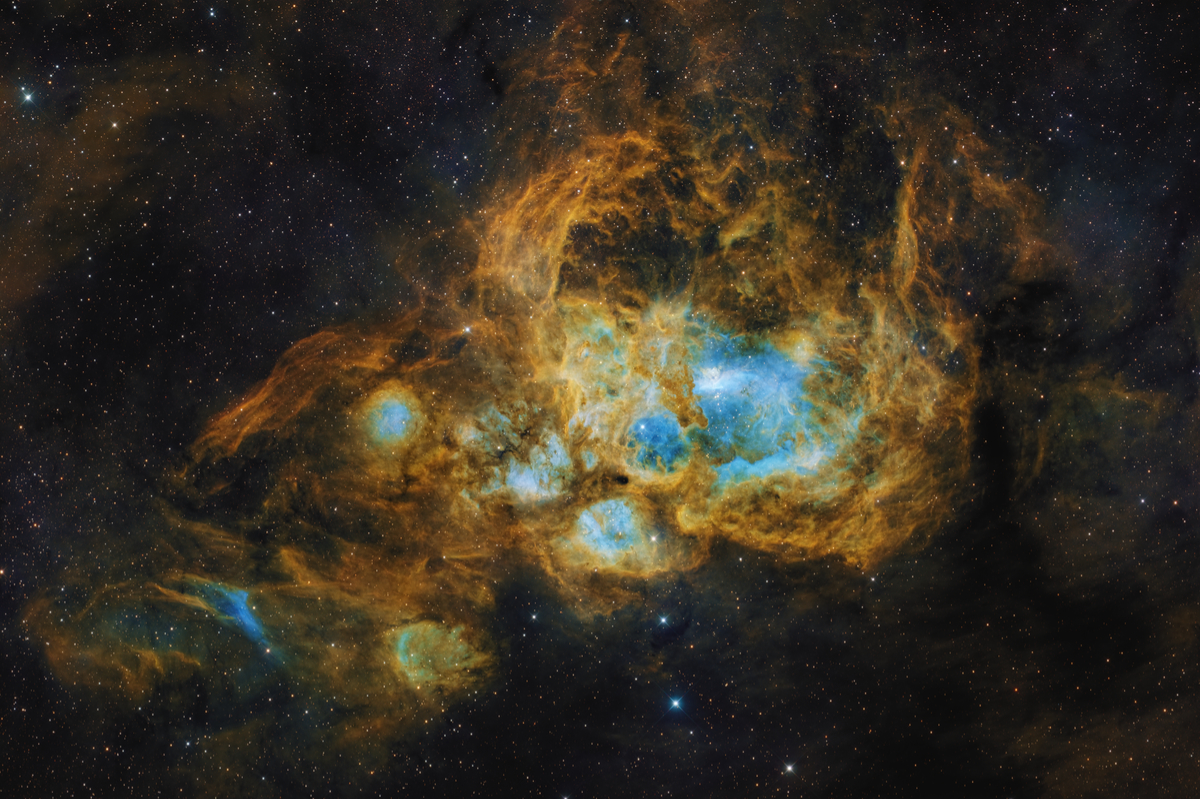
[back] NGC 6357 (Lobster Nebula / War and Peace Nebula) in Scorpius
100%
image RGB-version / 100% Bild RGB-Version (9412 x 6262, 0.743"/pixel)
100%
image SHO-version / 100% Bild SHO-Version (9412 x 6262, 0.743"/pixel)
Annotated 100%
image / Beschriftetes 100% Bild (9412 x 6262, 0.743"/pixel)

|
(c) 2025 All astro photo images are copyrighted. They may not be used or reproduced without explicit written permission from the authors. |
|
300" |
|
About this Image / Über dieses Bild
| Camera: | Moravian C3-PRO-61000 Mono CMOS |
| Image Type, Orientation: | (RGB-)SHO Color Composite, North is at 12:00 |
| Exposure time: | RGB: 18/18/19 x 300s, SII: 20 x 900s, H-alpha: 23 x 900s, OIII: 20 x 900s (20:20h total) |
| Exposure date: | July 18th... August 15tht, 2025 |
| Location: | Capella Observatory South at Kiripotib Astro Farm, Namibia |
| Filter: | Astronomik Deep-Sky Deep-Sky RGB Filter plus 6nm SII,Ha,OIII filter on Moravian EFW-3L-9-II External Filter Wheel |
| Instrument: | "Rhea", a PlaneWave DeltaRho 350, 1050mm focal length, 350mm aperture, f/3 on 10Micron GM2000 HPS II Combi |
| Photographer: | Rainer Raupach, Josef Pöpsel, Frank Sackenheim, Stefan Binnewies |
| Remarks: |
The star cluster most commonly cataloged as NGC 6357,
together with its associated nebula in the constellation Scorpius, is
colloquially known as the Lobster Nebula. Since infrared observations from
the Midcourse Space Experiment, it has also occasionally been referred to as
the War and Peace Nebula, because the central region resembles a dove, while
the eastern region has been likened to a skull. At the heart of the nebula lies the open cluster Pişmiş 24, home to some of the most massive known stars. For a long time, one of its brightest members, Pişmiş 24-1, was thought to be a single star of nearly 300 solar masses—the most massive individual star ever identified. It is now known, however, that Pişmiş 24-1 is at least a triple system [1]. Even so, its most massive component, of spectral type O3.5If*, weighs in at about 74 solar masses, while the second component, of type O4III, still reaches 66 solar masses. Also associated with Pişmiş 24 is the eastern Wolf–Rayet star WR 93, which has a mass of about 120 solar masses and a surface temperature of 71,000 K [2]. When rendered in the Hubble palette using narrowband SHO data, the nebula’s cavernous morphology is especially striking. Its interior is dominated by high-energy emission from doubly ionized oxygen (O III), which transitions outward into emission from hydrogen (Hα) and singly ionized sulfur (S II). Many parts of the inner region are obscured by dense concentrations of gas and molecular material. Within the nebula lie the young clusters G352.2+0.7 (to the east of Pişmiş 24) and G353.1+0.6 (to the southeast of Pişmiş 24), each containing roughly 800 stars, revealed primarily through their X-ray emission [3]. As an H II region, the nebula is also cataloged as Sharpless 11 or RCW 131, while as a radio source it is listed as Westerhout 22. NGC 6357 is further connected by a filamentary structure to its neighbor, NGC 6334, the Cat’s Paw Nebula. |
|
|
|
| Bemerkungen: |
Der meistens als NGC 6357
gelistete Sternhaufen mit assoziiertem Nebel im Sternbild Skorpion trägt den
Trivialnamen Hummernebel. Seit Infrarotaufnahmen des Midcourse Space
Experiments findet man manchmal auch den Namen War and Peace Nebula, weil
der zentrale Bereich mit einer Taube, der östliche mit einem Schädel
identifiziert wird. |
|
|
|
| References: |
[1] "ESA Science & Technology: Star on a
Hubble diet NGC 6357",
https://web.archive.org/web/20070404011712/http://www.spacetelescope.org/images/html/heic0619a.html [2] Fang, M.; et al. (2012). "Star formation and disk properties in Pismis 24". Astronomy & Astrophysics. 539: A119. https://arxiv.org/abs/1201.0833[3] Townsley, L. K.; et al. (2014). "The Massive Star-Forming Regions Omnibus X-Ray Catalog". Astrophysical Journal Supplement. 213 (1): 1. https://arxiv.org/abs/1403.2576 |
Back to the Diffuse Nebulae Overview / Zurück zur Diffuse-Nebel-Übersichtsseite